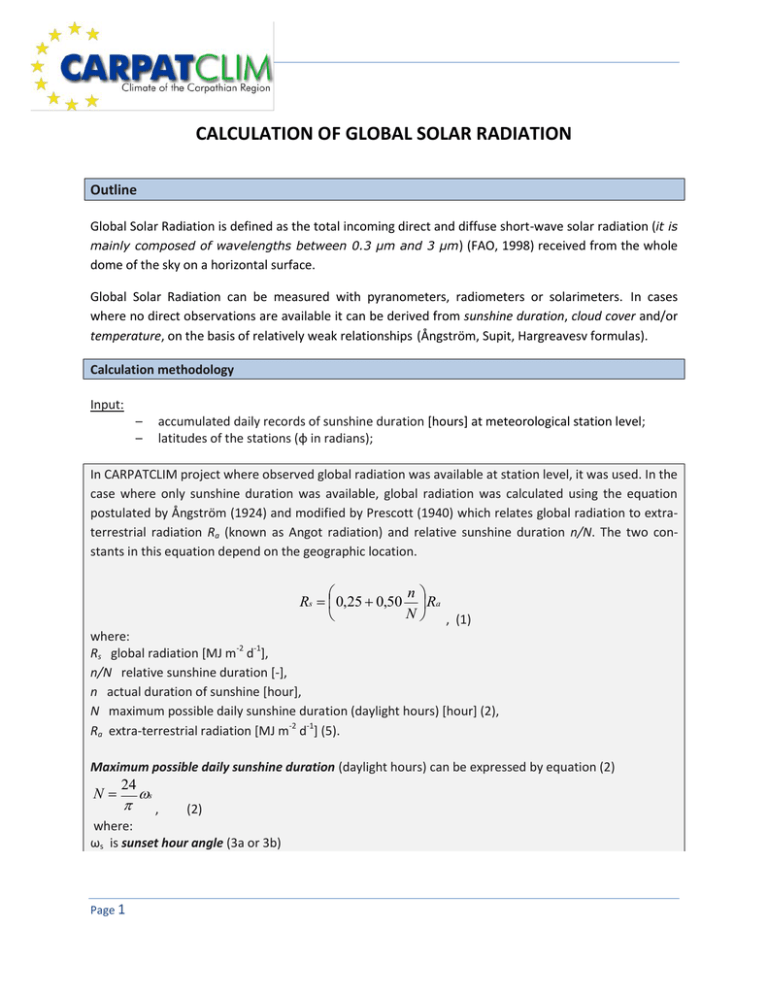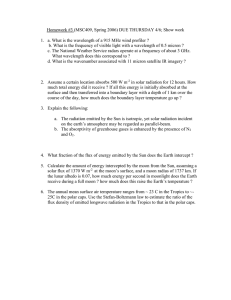calculation of global solar radiation
advertisement

CALCULATION OF GLOBAL SOLAR RADIATION Outline Global Solar Radiation is defined as the total incoming direct and diffuse short-wave solar radiation (it is mainly composed of wavelengths between 0.3 μm and 3 μm) (FAO, 1998) received from the whole dome of the sky on a horizontal surface. Global Solar Radiation can be measured with pyranometers, radiometers or solarimeters. In cases where no direct observations are available it can be derived from sunshine duration, cloud cover and/or temperature, on the basis of relatively weak relationships (Ångström, Supit, Hargreavesv formulas). Calculation methodology Input: – – accumulated daily records of sunshine duration [hours] at meteorological station level; latitudes of the stations (φ in radians); In CARPATCLIM project where observed global radiation was available at station level, it was used. In the case where only sunshine duration was available, global radiation was calculated using the equation postulated by Ångström (1924) and modified by Prescott (1940) which relates global radiation to extraterrestrial radiation Ra (known as Angot radiation) and relative sunshine duration n/N. The two constants in this equation depend on the geographic location. n Rs 0,25 0,50 Ra N , (1) where: Rs global radiation [MJ m-2 d-1], n/N relative sunshine duration [-], n actual duration of sunshine [hour], N maximum possible daily sunshine duration (daylight hours) [hour] (2), Ra extra-terrestrial radiation [MJ m-2 d-1] (5). Maximum possible daily sunshine duration (daylight hours) can be expressed by equation (2) N 24 s , (2) where: ωs is sunset hour angle (3a or 3b) Page 1 s arccos tan tan or s (3a) tan tan arctan 2 X 0,5 (3b) where , φ latitude [rad], δ solar declination (4), X = 1 – *tan(φ)+2 *tan(δ)+2 and X = 0,00001, if X ≤ 0. Conversion from decimal degrees to radians (used for latitude φ) is given by: radians 180 decimal deg rees . Solar declination δ can be expressed by equation (4) 2 J 1,39 365 , 0,409 sin (4) where, J – is the number of the day between 1 (1 January) and 365, or 366 (31 December). Extraterrestrial radiation Ra [MJ m-2 d-1] is expressed by equation (5) Ra 1440 Gscdrs sin sin( ) cos( ) cos( ) sin(s ) , (5) where Gsc – solar constant = 0,0820 [MJ m-2 min-1], dr inverse relative distance Earth-Sun (6), ωs is sunset hour angle (3a or 3b), φ latitude [rad], δ solar declination (4). Inverse relative distance Earth-Sun is expressed by equation (6) 2 dr 1 0,033 cos J 365 , (6) where J – is the number of the day between 1 (1 January) and 365, or 366 (31 December). Output: – daily (sums) global solar radiation [MJ/m2/day] interpolated into grids (0.1° x 0.1° DD (≈ 10 x 10 km)), covering the 1961–2010 time interval. Page 2 References: Ångström, A, 1924. – Solar and terrestrial radiation. Quarterly Journal of the Royal Meteorological Society, 50:121–125. Prescott, J.A., 1940. – Evaporation from a water surface in relation to solar radiation. Transactions of the Royal Society of South Australia, 64:114–118. Allen, R. G., Pereira, L. S., Raes, D., Smith, M., 1998. -– Crop Evapotranspiration. Guidelines for Computing Crop Water Requirements. FAO Irrigation and Drainage Paper 56. FAO, Rome. Page 3


